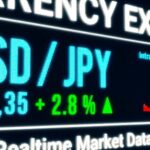Gold Continues Southbound Journey Amid Trade Cheer
Gold (XAUUSD) extended its downward trajectory on Thursday, falling to the $3,135 mark in the Asian trading session — its lowest level since April 10. The metal’s slump comes on the back of renewed optimism surrounding US-China trade relations and a shifting outlook for Federal Reserve monetary policy. Investors moved out of safe-haven assets like gold, redirecting flows toward riskier options as geopolitical tensions and recession fears began to ease.
This shift has been further magnified by reduced market expectations for aggressive Fed rate cuts in 2025. The Fed’s cautious tone and improving inflation data have led market participants to trim expectations for monetary easing, driving US Treasury yields higher and weakening demand for the non-yielding yellow metal.
US-China Trade Truce Eases Recession Fears
The breakthrough in US-China trade negotiations has served as a critical headwind for gold. Both countries agreed to suspend new tariffs for a 90-day period, effectively pausing a years-long dispute that rattled global markets. US President Joe Biden indicated openness to direct talks with Chinese President Xi Jinping — a potential sign of longer-term stability.
This détente reduces the probability of a near-term US recession, dampening the appeal of safe-haven assets such as gold. Market risk appetite has improved moderately, sending capital into equities and cyclical assets. Even a generally risk-off tone in global equities this week hasn’t been enough to halt gold’s decline, underscoring the strength of the bearish sentiment.
Fed Rate Cut Odds Shrink, Yields Surge
Another major factor weighing on gold is the shift in Fed expectations. Traders have reduced their forecasts for rate cuts in 2025 from over 100 basis points earlier in the year to just over 50 basis points currently. The recalibration of Fed rate bets has directly pushed benchmark 10-year Treasury yields to their highest level in over a month, making yield-bearing assets more attractive compared to gold.
Comments from key Fed officials have reinforced this sentiment. Vice Chair Philip Jefferson warned that tariffs and ongoing trade policy uncertainty might disrupt inflation progress, while also expressing confidence in the current policy stance. San Francisco Fed President Mary Daly echoed similar views, emphasizing the strength of the US economy and labor market and advocating patience before adjusting interest rates. Chicago Fed’s Austan Goolsbee stressed the lagging nature of inflation data and urged caution before drawing conclusions from April’s mixed figures.
Fed Speeches and US PPI in Spotlight
The next catalyst for gold could come from US macroeconomic data and central bank commentary. Investors await the release of the Producer Price Index (PPI) — a key indicator of inflationary pressures at the wholesale level — which could sway expectations for future Fed moves. A stronger-than-expected PPI reading could reinforce the “higher-for-longer” narrative, pushing yields higher and potentially accelerating the gold sell-off.
Additionally, Fed Chair Jerome Powell’s upcoming remarks are likely to be closely scrutinized for any hint of dovish or hawkish pivot. A reaffirmation of current policy caution could either consolidate existing expectations or shift them significantly depending on tone and nuance.
Geopolitical Risks Fail to Rescue Gold
While geopolitical instability typically supports gold prices, recent developments have failed to generate meaningful safe-haven demand. Despite ongoing hostilities in the Middle East and renewed tensions in Eastern Europe, gold remains under pressure.
Ukrainian President Volodymyr Zelenskyy confirmed his attendance at peace talks with Russia scheduled in Istanbul, but Russian President Vladimir Putin’s refusal to participate has added uncertainty to the outcome. Meanwhile, Israel continues its offensive in Gaza, with reports of up to 80 casualties following an intense wave of airstrikes. Additionally, a missile launched from Yemen toward Israeli territory on Wednesday underscores persistent instability in the region.
Despite these flare-ups, the broader market focus remains fixed on US inflation, monetary policy direction, and the easing of trade-related risks — all of which are currently unfavorable for gold.
Technical Breakdown Opens Room for Further Declines
From a technical standpoint, gold’s recent price action suggests a breakdown below several key support levels. The sustained move below the $3,150 region, combined with the failure to find bids near $3,140, points to continued weakness in the near term. Momentum indicators remain bearish, and the path of least resistance appears to be lower.
If sellers continue to dominate, gold could target the next psychological support zone around $3,100, followed by the $3,070-$3,080 area. A breach below this level could expose March lows and potentially shift the broader trend into a deeper corrective phase.
US Dollar Pauses as Traders Await Fresh Drivers
Despite the bearish undertone in gold, the US Dollar Index (DXY) has remained relatively subdued. Dollar bulls appear to be on standby, awaiting the outcome of today’s US PPI release and Powell’s commentary before committing further. Should the data support a resilient US economy and discourage dovish pivot expectations, the greenback could rally — further pressuring gold in the process.
That said, the muted USD action may be temporary, and a strong move in either direction post-data could provide a new directional impulse for gold markets.
Gold Market Outlook: Key Takeaways
- Gold continues to face pressure as US-China trade optimism reduces safe-haven demand.
- Fed officials are advocating patience, with fewer rate cuts now priced in for 2025.
- US Treasury yields are rising, making gold less attractive in a yield-seeking environment.
- Geopolitical risks remain elevated but are not significantly impacting gold prices.
- Upcoming US PPI data and Powell’s speech could be pivotal for the next leg of gold’s movement.
[faq-schema id=”39593″]









